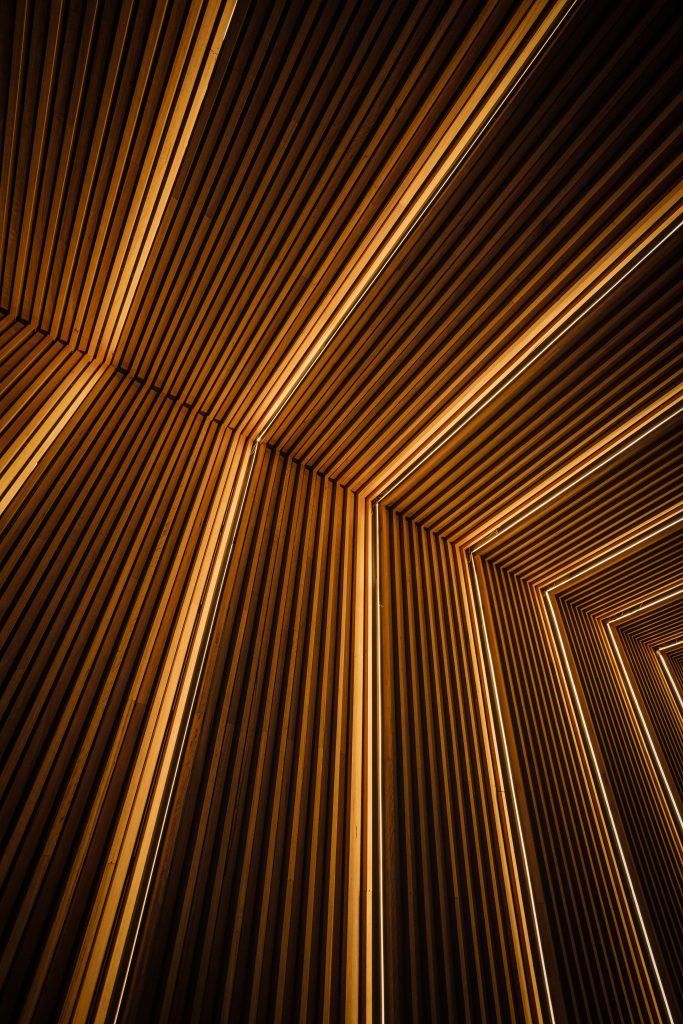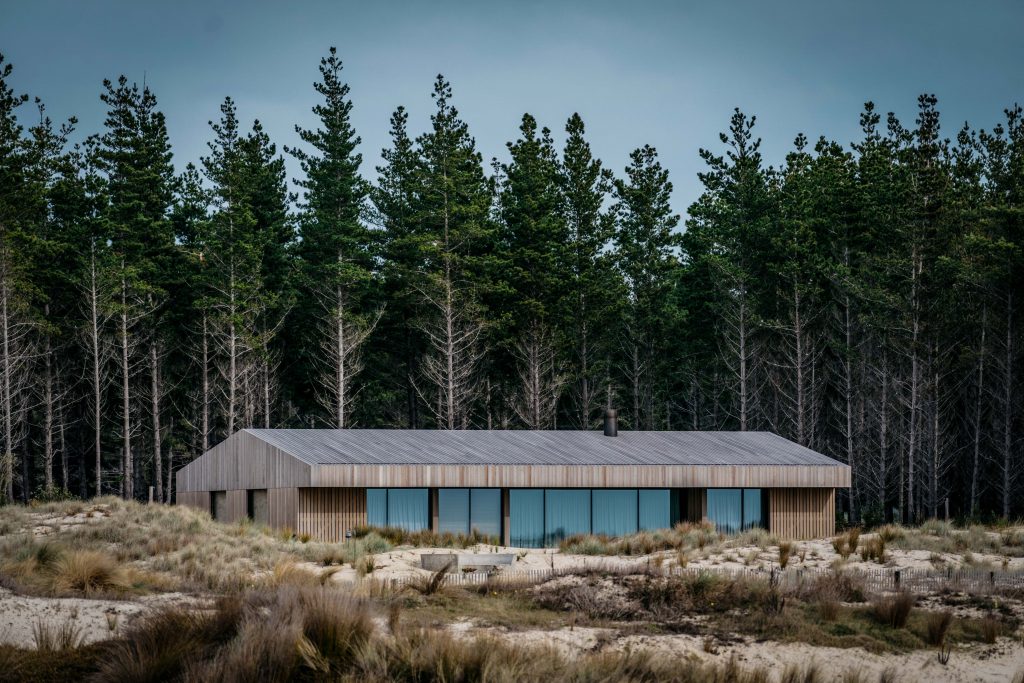How much wood would a woodchuck chuck, if a woodchuck could chuck wood? Well, hopefully just enough to help us construct some superbly sustainable and stunning structures made entirely from wood. It’s not exactly a major breakthrough, yet it is a significantly underestimated and underused material. Here is everything you need to know about wood.
Types of Wood in Construction
With so many species of wood to choose from, it’s important to do your research and know exactly which option works best for however you are going to use it. One terminology that might be worth noting is the meaning of and the difference between softwoods and hardwoods. Timber is classified under these two categories based on its physical composition. Timber types vary in terms of aesthetic, density, and how easy they are to work with.
Despite the names, this says nothing about their density or durability. A tree is classed as being a hardwood or softwood depending on the seed they produce.

Softwoods are usually grown on plantations, are evergreens meaning they do not shed their leaves every year and often have pine-shaped needles. For instance, cedar, Douglas fir and pine classify as softwoods. They are versatile, easy to work with, and offer a very aesthetically pleasing finish. However, they have a lower density than hardwoods, making them less durable. In construction, softwoods can be used for feature walls, ceilings, furniture, doors, and windows.
In contrast, hardwoods are mostly broadleaved, though some are evergreens, and tend to grow more slowly which leads to denser wood. Eucalyptus and mahogany are just two examples of hardwoods. They can be utilised both indoor and outdoor. Hardwoods are commonly used for flooring, but they can also be employed for cladding, panelling, fencing and outdoor decks. Hardwoods should be considered when durability and strength are to be prioritised.
Uses of Wood in Construction
Timber has been employed for construction purposes for centuries. As a result, there are multiple ways of using wood in terms of the shape, height, and overall form of the building.
- Old Timber
If you’re doubting wood as a construction material, here is the proof you need of just how durable it really is. The Horyu-ji Buddhist temple in Japan is thought to be one of the world’s oldest timber buildings with a five-storey pagoda (tower), constructed about 1,300 years ago. If timber remains dry, it usually won’t decay. This can usually be protected from rain using simple methods, having a roof and a waterproof outer shell, but the secret is preventing moisture from the ground from coming into contact with the wood. In the 12th century Europeans worked out that by placing timber buildings on stone footings, they could avoid decay and extend the life of the building. - Tall Timber
Also known as engineered timber. Since 2000, there has been a revitalisation of the trend to build fairly tall urban buildings from timber. This was thanks to the performance-based building codes which were introduced around the same time and allowed more freedom in construction. The tallest timber building in the world to date is Mjøstårnet in Norway which was completed in 2019. With 18 storeys, it stands at a height of 85 metres. you’ll find out below timber absorbs CO2, meaning the taller the building made of wood, the more timber is used and therefore the more CO2 is absorbed, helping us in the fight against climate change. - Short Timber
While tall timber is the current trend, prior to this, wood was primarily used only for small, short structures. Low-rise buildings can be advantageous. For instance, they are more resistant to natural impacts, which could be useful in parts of the world prone to natural disasters. Additionally, you can easily control the temperature of the building and the building therefore consumes less energy. Such structures also tend to incur lower maintenance costs. Larch Corner Passivhaus in Warwickshire (UK) is a low-built detached home constructed entirely from timber. With its’ Passivhaus-certified levels of energy efficiency, it is a true net zero home. - Large Timber
Large timber constructions, like short timber buildings, have been around for a while. Although they used to be few and far between, and quite literally: they would often be more like large showpieces distanced far away from neighbouring buildings. Now, with the climate crisis imminent and the need for sustainable construction becoming increasingly evident, the use of large timber constructions could just be the answer. Dalston Lane in London is a high-density housing development with 121 units and 10 storeys. 100% of the development is made from cross-laminated timber (CLT), “from the first floor upwards, with core walls, through to the floors and stairs all made from the material”.

Wood Around the World
While the Europeans build one way, in America and Asia there are different methods; but there’s no right or wrong answer. What works here, might not work there. It’s all about making use of what we’ve got around us and building in a way that best suits the local terrain and climate. Here are just a few examples:
- Traditional wooden houses with post and beam frames are still regularly built in Japan.
- Modern Swedish timber frame houses are an evolution of the old method of using vertical posts or horizontal boards.
- Log walls are still constructed, though mainly only for smaller buildings. Finland is one of the few countries where larger buildings are constructed with dovetailed log walls.
- Log building is less common in the USA, where they prefer the use of external wood cladding which is applied horizontally. Horizontal cladding is predominantly used in climates with a lot of driving rain. E.g., the Norwegian coast and western Canada.
- Timber frame structures are common in North America, where they are mostly built on-site.
Advantages
Here’s a run-down of a few advantages of using timber in construction.
- Both softwoods and hardwoods are a more sustainable option than conventional materials. Softwood timber may be considered the more sustainable of the two because it has a faster growth rate. Although hardwood trees may take up to 100 years to be fully grown, it should be remembered that hardwood lasts longer and is more durable.
- When looked after and constructed correctly, timber is durable. It really does stand the test of time (see above).
- Compared to the cost of construction with conventional materials, like steel and concrete, building with timber could actually reduce the total cost of the project.
- As timber is lightweight, the foundation loads can be reduced by 30-45% and secondary steelwork is either not needed or reduced. This means significantly cutting back on the amount of finite, unsustainable raw materials used in construction.
- Timber has less than half the embodied carbon of concrete.
- Wood is carbon negative and with construction producing over 1/3 of CO2 emissions in the EU, this could be one of the materials to save the day. As a store of CO2 and by allowing us to use a less CO2-intensive material than concrete and steel, timber buildings can help to reduce these emissions.
- Timber is also easier to take apart, re-purpose, and reuse in other structures – making it perfect for urban mining.
“A timber house that is dismantled after use does not leave any non-recyclable rubble but useable wood.”
Binderholz
- You might have done a double take but it’s true, timber is pretty much fire resistant. Wood chars as it burns, meaning the process is incredibly slow.
- Timber usually has better thermal performance than masonry structures while also being thinner and thus saving space.
- Using wood as a construction material can help to effectively regulate temperature and humidity peaks. This could in turn save on heating and air-conditioning, reducing energy consumption, resources and costs.
- Given the multiple examples above, perhaps it goes without saying, but wood is an incredibly strong and robust material.
- Using the method employed at Dalston Lane, cross-laminated timber, puts wood that would otherwise be wasted to good use. E.g., they take wood from overgrown or diseased forests which have to be thinned or cut down.
Disadvantages
- The biggest issue for wood is moisture:
- Condensation can be problematic for the structure as it could decay the timber frame.
- If poorly maintained, the external timber elements can rot over time too.
- Timber can absorb water and therefore shrink and expand. Timber used in construction requires appropriate treatment and some (though not all) of these preservatives may be harmful to humans and/or the environment.
- Wood cannot achieve the same level of sound insulation as concrete or masonry.
- Use of timber construction is limited to traditional houses – contemporary designs, even elements such as large windows, can be difficult to achieve.
- Building codes currently restrict the height of wooden buildings, although this is changing.
Just a Note
If wood is to be your material of choice for your project, that is a tremendous first step. However, if you want to go that one step further to ensure that you’re working as sustainably as possible – which is definitely something we’d encourage – then here’s something to bear in mind.
In an interview, the architect and circular building expert Thomas Romm explained the current issue with wood. “We have a lot of problems with sustainable wood procurement and the sustainable label”, Thomas continued, “Greenpeace has also stopped with all the labels recently, which they themselves as an NGO co-founded, because everyone knows that these monitoring systems don’t work well enough”. He is convinced that new regulations are required and that “it should be forbidden to bring non-sustainably produced wood onto the market”.
So, how can we sustainably build with wood here and how? No problemo, CityChanger, it is definitely possible to do so. First, depending on how you are employing the timber in your project, perhaps consider using reused or recycled wood. Around 5 million tonnes of waste wood are generated annually in the UK alone – why not try to save a tonne or two from ending up unused and unloved?
Secondly, when using ‘new’ wood, make sure you choose a wood species that is appropriate for its’ purpose in the construction but that can also be locally sourced. This means it isn’t travelling far to reach your construction site, cutting down on CO2 emissions.
Thirdly, check with the provider/manufacturer what the growth cycle of this timber is. i.e., when a tree is chopped down, is another replanted and does this happen every time? Of course, there are certifications that you can look out for depending on where you are in the world, but as Thomas pointed out, this isn’t always the most reliable way of ensuring you’ve got the most sustainable wood. It’s worth doing your research, asking and double checking for yourself.
Wood in a Nutshell
Clearly, we need to be changing the way we think about buildings and how we construct them. The materials used to do so can help us take a giant leap towards a more sustainable method of construction. If wood didn’t quite float your boat, no problem! Why not take a look at all the options and the general areas to bear in mind when working with natural building materials here. Alternatively take a look at some of the other fact files:



I had no idea that log building is less common in the USA. I think of logan cabins whenever I hear the term construction timber. I’m sure that the right timber is still important in construction.